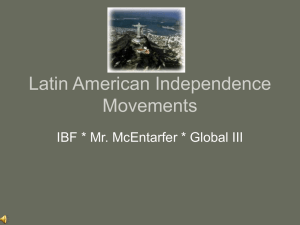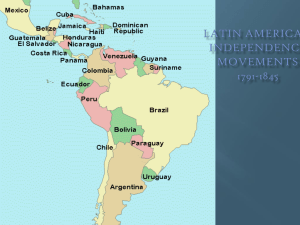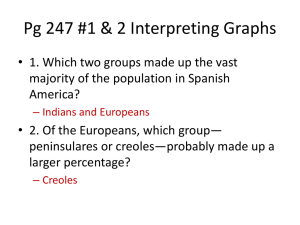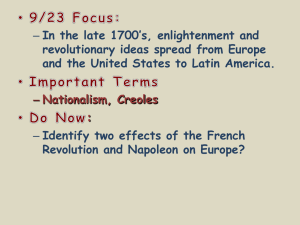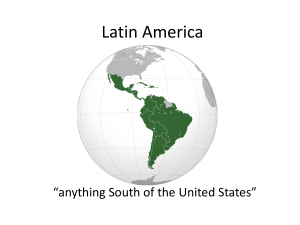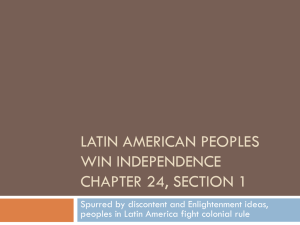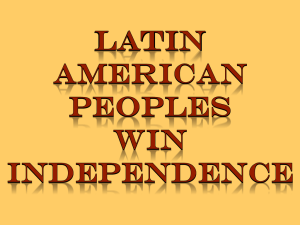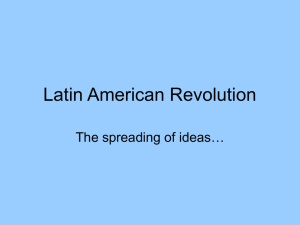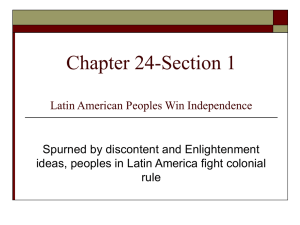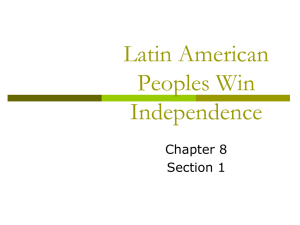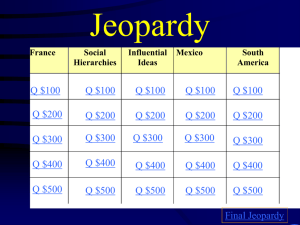Ch8Sec3
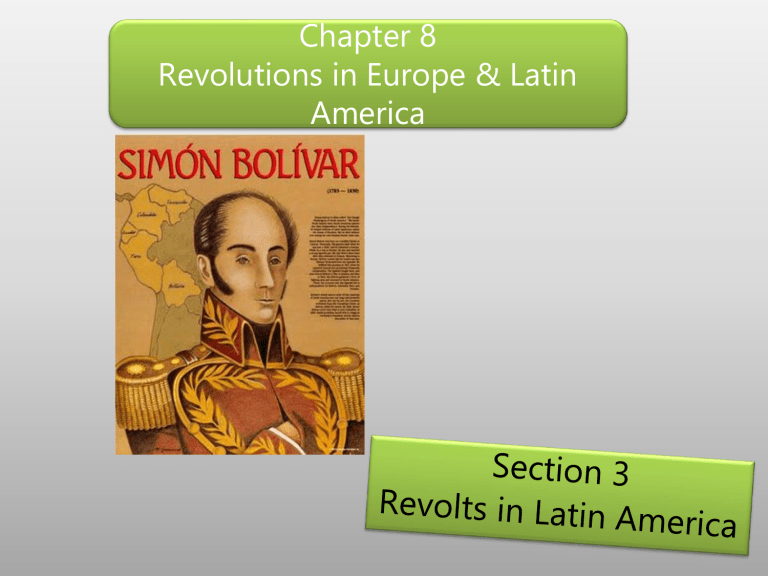
Chapter 8
Revolutions in Europe & Latin
America
Revolts in Latin America
Ideas of freedom, liberty, and equality were spreading to Latin
America. From Mexico to the tip of South American, revolutionary movements arose to overthrow the reigning European powers. By
1825, most of Latin America was freed form colonial rule.
Discontent Fans the Fires
By the late 1700s, the revolutionary ideas that were active in
Western Europe had spread to Latin America. The Latin Americans were angry about the social, racial, and political system that existed in Latin America during the 300 years of Spanish rule.
Social & Ethnic Structures Cause Resentment
Peninsulares
*Spanish born people who made up the highest social class.
*Dominated Latin American political & social life.
*Held top jobs in government and the church.
Creoles
*European-descended Latin Americans.
*Owned the haciendas (ranches) and mines.
*Resented their second-class status
Mestizos
*Growing population of Native American and European descent.
*Angry at being denied the status, wealth, and power that were available to whites. Suffered economic misery under the Spanish, who had conquered the lands of their ancestors.
Mulattoes
*People of African descent.
*In the Caribbean region & South America, many of these people were enslaved and forced to work on plantations.
The Enlightenment Inspires Latin Americans
In the 1700s, educated creoles read the works of Enlightenment thinkers. They watched colonists in North America throw off
British rule. Translations of the Declaration of Independence and the Constitution of the United State circulated among the Creole elite.
During the French Revolution, young creoles like Simon Bolivar traveled in Europe and were inspired by the ideas of liberty and freedom. Unfortunately, many were afraid to take action in Latin
America.
Napoleon Invades Spain
The spark that finally ignited widespread rebellion in Latin America was Napoleon’s invasion of Spain in 1808. Napoleon replaced the
Spanish king with his brother Joseph. In Latin America, leaders saw Spain’s weakness as an opportunity to demand independence from colonial rule.
Slaves Win Freedom for Haiti
Haiti was a French owned colony in Latin America. French planters owned very profitable sugar plantations worked by nearly a half million enslaved Africans.
In 1791, the slaves rose up in revolt against the plantation owners.
A self-educated former slave named, Toussaint L’Ouverture led the revolt. Toussaint led an army of former slaves against the French planters (who were joined by some mulatoes). France, Spain, and
Britain all sent armies to help the French planters fight against the rebel slaves. The fighting took many lives and by 1798, the rebels had achieved their goal. Slavery was abolished and Toussaint’s forces controlled most of the island.
Haiti Wins Independence
In 1802, Napoleon sent a large army to re-conquer Haiti.
Toussaint wanted to battle the French, but the French army arrested him and sent him to a prison in France to die.
The battle for Haiti continued. By late 1803, most of the French army had become infected with yellow fever. As a result, the
French surrendered . In January 1804, Haiti declared itself an independent country.
Mexico and Central America Revolt
The slave revolt in Haiti frightened creoles in Spanish America.
Although they wanted power themselves, most had no desire for economic or social changes that might threaten their way of life.
Father Hidalgo
*Creole priest from Mexico
*Presided over the poor rural parish of Dolores
*On September 15, 1810, he gave a speech motivating the
Mexicans to end slavery, improve conditions for Native Americans, and fight for independence.
A small army of poor mestizos and Native Americans joined together to fight. The creoles were against the priest and the
Mexican revolution because they did not want to lose their current social status. Less than a year after the priest gave his famous speech, he was captured and executed.
Father Jose Morelos
*Mestizo
*Wanted to improve conditions for Mexicans, abolish slavery, and give the vote to all men.
*He led a rebel army to fight for his cause but was captured and shot in 1815.
Spanish forces helped out the creoles who were worried about losing their middle class status and almost succeeded in ending the rebel movement when events in Spain had unexpected effects.
Mexico Wins Independence
In 1820, Spain created a Constitution for its country. Mexicans were afraid that this new Constitution would affect Spanish colonies. creoles, mestizos, and Native Americans in Mexico came together to overthrew the Spanish and became independent.
By the early 1820s, Spanish-ruled lands in Central America began to declare independence.
Revolution Ignites South America
In 1810, Simon Bolivar led an uprising in Venezuela. He was forced into exile twice as civil war raged in the country. After many defeats and a few key victories, Bolivar successfully liberated
Venezuela in 1821.
After helping Venezuela become free, Bolivar moved south into
Ecuador, Peru, and Bolivia where he joined forces with another great leader named Jose de San Martin.
Jose de San Martin
*Creole- born in Argentina.
*Went to military school in Europe
*Helped Argentina win freedom from Spain in 1816.
*Joined forces with Simon Bolivar to help Chile and Peru gain their freedom from the Spanish.
Freedom Leads to Power Struggle
The wars for independence in Latin America came to and end by
1824. The original plan to make Latin America one large country failed due to rivalries between Latin American nations. Even though Latin America gained its independence from Spain, they did not accomplish the goal of creating a unified Latin American nation.
